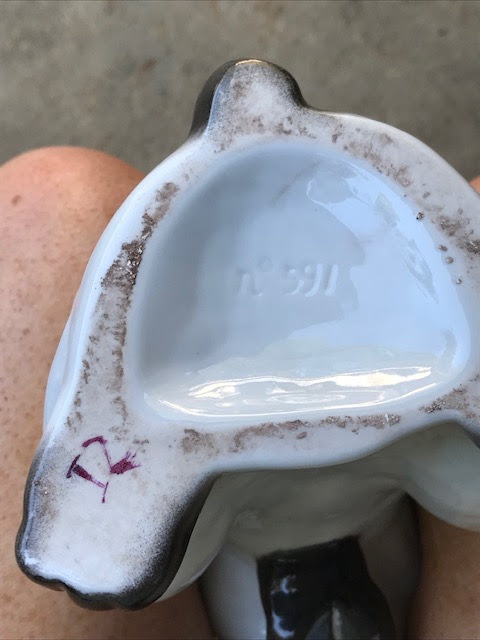I hear from a great many of my blog readers with questions about individual pieces of majolica they may own. I’m happy to help when I can but most are disappointed with my responses. There’s a great deal of reproduction majolica on the market and it’s very easy for a novice collector to be fooled. Here are a couple of recent examples I’ve received.
Q: I found your name on a Pinterest and wondered if you could help me identify a pitcher. It’s a white rabbit pitcher, ears are the handle. You show a pic of one just like it. I believe it is a St. Clement pitcher, has 3 numbers and an odd mark on the bottom. It doesn’t match. anything in your description.
A: In my opinion your pitcher is a modern reproduction. The St. Clement factory was founded in 1758 and remains active to this day. The production of faience was discontinued in 1930. For more on the factory here is the listing from The Majolica International Society: http://majolicasociety.com/st-clement
Q: I've come across your blog yesterday while doing a bit of research on the piece in the picture, which my husband brought home a few days ago. I assume that it's not old at all and a modern majolica - style reproduction?! I do like how it looks in our home and only £20 were paid so I wasn't too disappointed to see a very similar one (repro/ fake- warning) on your blog. Could you nevertheless provide me with some details/ information on the piece, please?
A: You were correct in your assumption that the piece is new, probably manufactured in the past ten years. Many similar pieces enter the wholesale market from Asia where they are created for decorative use. By law they should have a paper label on them designating country of origin but these labels are often removed by dealers who try to sell them as antique. I don’t know the inspiration source but it appears to be an amalgamation of two or three different neo-renaissance French majolica pieces I have seen. It could be a complete fantasy or an interpretation of an existing piece that I am not familiar with.
I don’t give values on my blog but £20 seems a fair enough price for what it is. It really looks very nice in your photo with the white flowers in it.
Sometimes I’ll get an interesting email from a researcher seeking information. This reader was interested in the destruction of the Minton majolica St. George fountain at Bethnal Green. I assisted them as best I could and in return they were kind enough to share some information they had found that I thought I’d pass on to my readers:





No comments:
Post a Comment